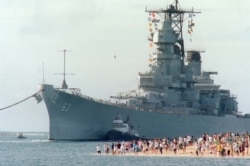It was quite a sight when the World War II-era battleship the USS Missouri fired her guns in anger for the final time.
First there were billows of smoke so dense that we could still see them against the darkness of the night-sky from a nearby warship, Britain’s HMS Gloucester. Then huge orange fireballs spat from her 16-inch guns which were targeting Iraqi positions along the Kuwaiti coast.
Sharp cracks and thunderous booms followed even before the smoke had dissipated — so ear-piercing that I ripped my neck jerking away from the roar. Then a few seconds later, we could feel the thud of the Missouri’s shells landing on targets twenty miles away.
The Missouri, a veteran from the battles of Iwo Jima and Okinawa, has a storied history. But for many people the Missouri’s greatest claim to fame is hosting the signing of the formal surrender in 1945 by the Japanese 75 years ago Wednesday, as the 45,000-ton battleship lay at anchor in Tokyo Bay.
V-J Day, an abbreviation for Victory over Japan Day, had been celebrated almost a month earlier on August 15 by many Allied nations, the day the Japanese government announced surrender. The U.S. marks V-J Day on September 2, the day three-quarters-of-a-century ago when Japan’s foreign minister, Mamoru Shigemitsu, and Gen. Yoshijiro Umezu signed their names to the Instrument of Surrender, which had been approved by U.S. President Harry Truman.
It set out in eight short paragraphs Japan’s unconditional capitulation.
The second paragraph read: “We hereby proclaim the unconditional surrender to the Allied Powers of the Japanese Imperial General Headquarters and of all Japanese armed forces and all armed forces under Japanese control wherever situated.” U.S. Gen. Douglas MacArthur also signed, as did others for the Allied forces.
Japan’s foreign minister removed his top hat and white gloves to sign. Thousands of sailors from the Missouri and other allied warships crammed on the gun turrets, earning by ballot their place to witness a momentous moment in world history. On the warship’s teak decks it was more orderly with officers lined up drawn “from the countries that were involved in World War II,” recalled Lieutenant Robert G. Mackey in an interview with the Library of Congress’ Veterans History Project.
He remembered there was a last-minute scramble before the Japanese representatives arrived to find an appropriate table to use for the ceremony.
“The British sent us over this table and it's not big enough and I don't want it on a British table anyway,” Harold Stassen, an aide to Admiral William Halsey, told Mackey, who suggested the table from the officers’ mess. They overlaid the table with a green felt cloth the ship’s officers used for playing cards. “It looks all right to me!” Mackey told Stassen.
In twenty-three minutes the ceremony was over.
But the memory for the men on board the Missouri remained vivid decades later. Walter Garth Holmes, a U.S. Marine, recalled in a 2015 interview with a local television station: “I was that close to where General MacArthur was and he had his corn cob pipe, which is what he's famous for and his chest full of ribbons.” Holmes was 20 years old at the time. “His cap was turned sort of cocked. He was in charge. That's what I remember about him.”
MacArthur began the brief ceremony with a short speech. He noted: “It is my earnest hope and, indeed, the hope of all mankind, that from this solemn occasion a better world shall emerge out of the blood and carnage of the past; a world founded upon faith and understanding, a world dedicated to the dignity of man and the fulfillment of his most cherished wish, for freedom, tolerance and justice.”
He referred to the atomic bomb attacks on Hiroshima and Nagasaki, which had persuaded Japan to capitulate, saying the blasts had “revised the traditional concept of war.” The world had had its last chance, the general noted, warning that the world had to devise a more equitable system or Armageddon would be at its door.
Five years later both MacArthur and the Missouri were at war once again.
The Missouri was the first American battleship to arrive in Korean waters after North Korea invaded the South in 1950, firing her massive guns for the first time since World War II in a bid to divert attention from the Incheon landings by United Nations forces.
She was to repeat the feint the night I saw her blasting away at the Kuwaiti coast in 1991, a bombardment aimed largely at tricking the Iraqis into thinking allied forces were about to mount an amphibious landing rather than launch a ground assault from Saudi Arabia. The Missouri received a total of 11 battle stars for service in World War II, Korea, and the Persian Gulf.
She survived some near misses. In April 1942, a kamikaze Zero warplane crashed into Missouri's starboard side, striking just below her main deck. In 1991, the Missouri was also targeted, this time by an Iraqi Silkworm missile. That threat was intercepted by Sea Dart missiles fired by Britain’s HMS Gloucester.
Finally decommissioned on 31 March 1992, the Missouri is now a floating museum at Pearl Harbor in Hawaii. The dent on her side from the kamikaze attack can still be seen.














